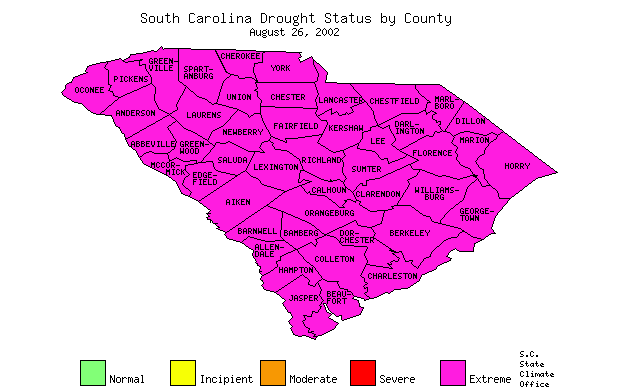

For previously issued drought statements see the archived status reports.
Table of all counties and drought status.The South Carolina Drought Response Committee has upgraded the final seven counties to "extreme" drought status, meaning that all 46 counties in the state are now included in the most dire drought category.
All of South Carolina, with the exception of seven counties, has been listed in the extreme drought status since July 24. The counties that now join the extreme drought category are Bamberg, Berkeley, Beaufort, Charleston, Colleton, Dorchester and Orangeburg. The Southern Drought Response Committee voted Aug. 20 in Columbia to upgrade the seven counties to extreme status given the agriculture and forestry conditions. The Southern Drought Response Committee motion stated, "Conservation efforts by local water suppliers will be determined by them contingent upon water supply availability."
The Drought Response Committee has not yet recommended statewide or regional mandatory water restrictions. However, local officials may call for mandatory or voluntary restrictions as part of their local response.
The S.C. Department of Natural Resources (DNR), which convenes the Drought Response Committee, conducted a survey of the largest 350 water systems in the state to determine the conservation measures in place and the success of these measures. According to Hope Mizzell, DNR statewide drought coordinator, 29 water systems are asking for mandatory restrictions, with most of these systems reporting an 11-20 percent water-use reduction. Of the water systems surveyed, 104 are asking for voluntary reductions in water use, with most of these seeing less than a 10 percent reduction in use.
Industries in the Pee Dee area of the state are spending significant amounts of money to deal with the drought, according to David Baize of the S.C. Department of Health and Environmental Control. Baize estimated that Pee Dee industries are spending hundreds of thousands to millions of dollars on measures such as installment of water-saving devices, digging new wells and building retention ponds and cooling towers.
Jim Witkowski of International Paper, representing the Central Drought Management Committee, said: "We have seen most industries within the Central Drought Management Area take action wherever possible to reduce water use. Most companies have seen significant water-use reduction since the call for voluntary conservation." Witkowski said the International Paper plant in Eastover has reduced its water use by 1.7 million gallons a day.
Wildfire losses continue to grow, according to Ken Cabe, information officer with the S.C. Forestry Commission. Since Jan. 1, Forestry Commission firefighters have responded to more than 4,000 wildfires across the state. These fires damaged or destroyed 77 homes, 120 outbuildings, 75 vehicles and almost 40,000 acres of woods and grasslands. Firefighters say that fires are becoming harder to control, as heavy logs and stumps now ignite and burn intensely.
The Climate Prediction Center (CPC) forecast continues to call for below normal rainfall for September through October 2002 in the mid-Atlantic states and southward through North Carolina and northern South Carolina. Hope Mizzell emphasized that even with normal rainfall this fall October and November are traditionally our driest months with an average of 3.42 inches in October and 3.16 inches in November. The CPC forecast calls for normal to above normal precipiation for South Carolina from December through April. Mizzell explained that this forecast is based on the expected development and intensification of the El Nino phenomenon in the equatorial Pacific. A moderate El Nino usually brings South Carolina above normal winter and early spring rainfall.
Contact Dr. Mizzell in Columbia at (803) 734-9568 or e-mail at mizzellh@dnr.sc.gov for more information.
DNR protects and manages South Carolina's natural resources by making wise and balanced decisions for the benefit of the state's natural resources and its people. Find out more about DNR at the DNR Web site.
| Current Drought Status by County | ||||
|---|---|---|---|---|
| Normal | Incipient | Moderate | Severe | Extreme |
| County Status |
County Status |
County Status |
County Status |
County Status |
| ABBEVILLE Extreme |
AIKEN Extreme |
ALLENDALE Extreme |
ANDERSON Extreme |
BAMBERG Extreme |
| BARNWELL Extreme |
BEAUFORT Extreme |
BERKELEY Extreme |
CALHOUN Extreme |
CHARLESTON Extreme |
| CHEROKEE Extreme |
CHESTER Extreme |
CHESTERFIELD Extreme |
CLARENDON Extreme |
COLLETON Extreme |
| DARLINGTON Extreme |
DILLON Extreme |
DORCHESTER Extreme |
EDGEFIELD Extreme |
FAIRFIELD Extreme |
| FLORENCE Extreme |
GEORGETOWN Extreme |
GREENVILLE Extreme |
GREENWOOD Extreme |
HAMPTON Extreme |
| HORRY Extreme |
JASPER Extreme |
KERSHAW Extreme |
LANCASTER Extreme |
LAURENS Extreme |
| LEE Extreme |
LEXINGTON Extreme |
MARION Extreme |
MARLBORO Extreme |
MCCORMICK Extreme |
| NEWBERRY Extreme |
OCONEE Extreme |
ORANGEBURG Extreme |
PICKENS Extreme |
RICHLAND Extreme |
| SALUDA Extreme |
SPARTANBURG Extreme |
SUMTER Extreme |
UNION Extreme |
WILLIAMSBURG Extreme |
| YORK Extreme |
||||
| SC Drought Response Committee Meeting, August 26, 2002 Sign-In sheet | |
|---|---|
| Name & Agency | Name & Agency |
Find out more about the State Climatology Office at https://www.dnr.sc.gov/climate/sco/ or by calling (803) 734-9100.
